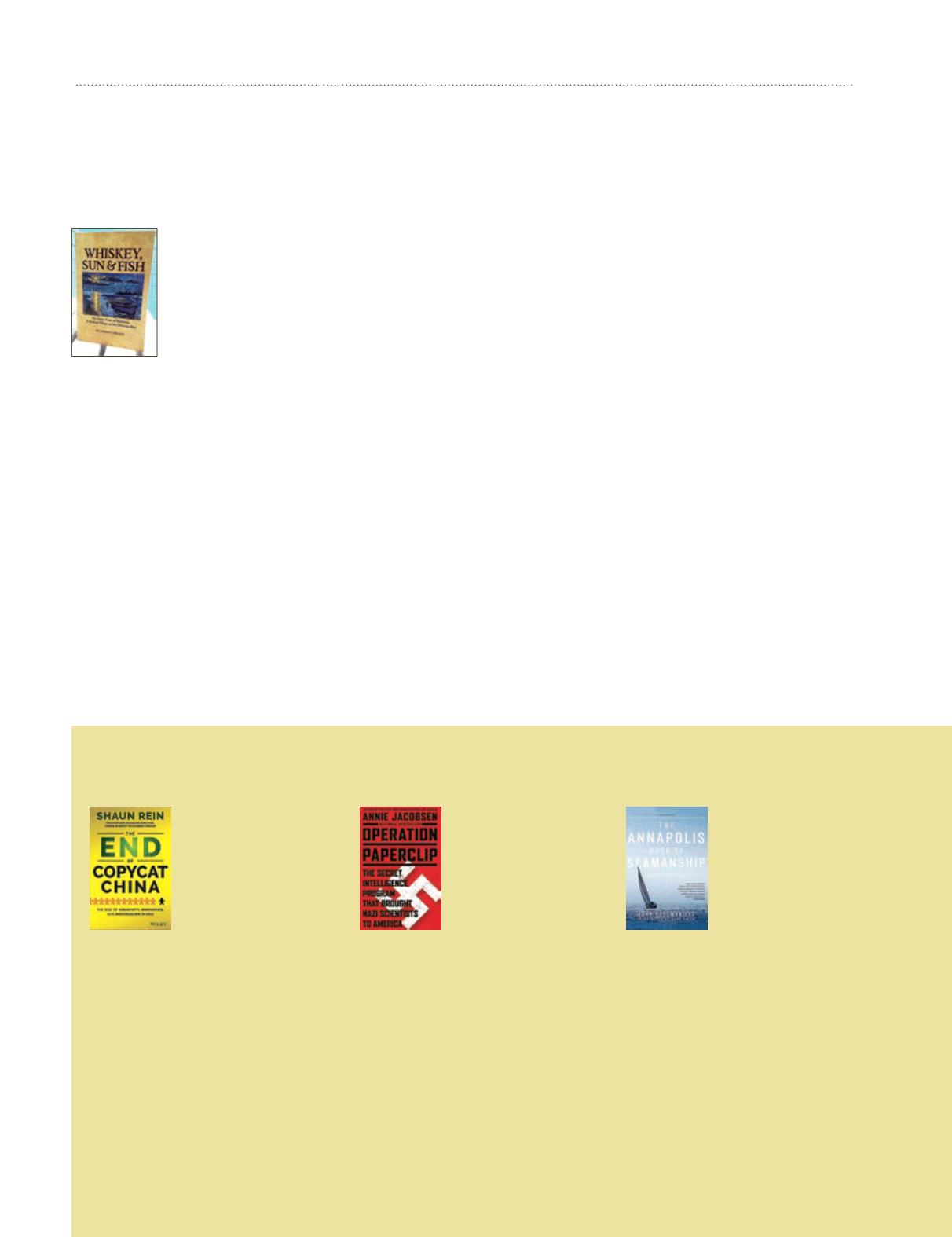
Whiskey, Sun & Fish:
The Early Years
of Fortesque,
A Fishing Village
on the Delaware Bay
by George Carlisle,
faculty emeritus
Exit Zero Press, 80 pages, $14.95
Reviewed by Frederick Dillen ’64
Here is a jewel of a book. George Carlisle,
who taught creative writing at St. Paul’s
for 45 years, has written of exploring a
village he’d known and loved as a boy,
more than 50 years ago. Carlisle, as his
students might expect, writes with sim-
plicity, clarity, and particularity – and
with the love that brings a place to life.
Fortesque is a place insignificant
enough to be all but beneath notice. Yet its
history is a microcosm of mid-Atlantic
shore cultures, populated with the aspira-
tions, joys, and mosquito bites of genera-
The End of Copycat
China: The Rise of
Creativity, Innovation,
and Individualism
in Asia
Shaun Rein ’96
Rein helps business
executives and invest-
ors understand how China’s economy
is shifting from heavy investment to
services and consumption through
insights that help shape effective
strategy. Drawing from 50,000 inter-
views with entrepreneurs, venture
capitalists, private equity investors,
private Chinese companies, and multi-
nationals, this book describes how
Chinese firms are increasingly focused
on innovation and how consumers
are evolving with their hopes, dreams
and aspirations.
On the Shelf . . .
as word of the splendid beach spread,
hotels were cobbled out of houses and
re-cobbled after fires. A fleet of oyster
boats, party boats, and small commer-
cial fishing boats, supported unsteady
wharfs, and pavilion dances delivered
parochial summer rapture until winter
closed the season.
Carlisle has uncovered accounts of the
oyster war and prohibition smuggling.
Found within his interviews of 56 years
ago, locals tell in singular voice of a tiny
community in the best of times. The same
voices remember the decay of those times.
And they report the stasis of a still-cher-
ished place and the seasonal souls who
come for what fish remain.
Here is a book of feeling and loss, as all
good summer books must be. It is also
the briefest snapshot of an unfurling
American moment that radiates through
time and geography and the passage of
one’s own life. Read
Whiskey, Sun & Fish
,
and, when you’re done, think gratefully
of George Carlisle for what he’s given us.
tions of individuals as they harvest a wealth
of fish, as they ride on a boom of summer
tourists, as their harvest dwindles to hobby,
and as the subsiding boom leaves hap-
hazard hotels at the mercy of fire and storm.
This is an 80-page book that begs to be
read slowly, at leisure, and, if possible, at
the shore in summer. Carlisle palpably
evokes the passage out across miles of
salt marsh to Fortesque and the trials of
early visitors who came and camped for
the privilege of abundant weak-fish –
“croakers” they were called – and oysters
and clams and brackish drinking water,
when drinking water could be found.
Framing these evocations are the divid-
ing up of properties and the establishment
of enduring families.
Fortesque was a destination for blue-
collar merchants and craftsmen, who
came in ones and twos and then greater
numbers with families and church picnics,
as logs were latticed across the marshes
to bear the traffic of horse-drawn wagons.
Small houses were built a yard apart, and,
Operation Paperclip:
The Secret Intelligence
Program that Brought
Nazi Scientists to
America
Annie Jacobsen ’85
In the chaos following
World War II, the U.S.
government faced difficult decisions,
including what to do with the Third
Reich’s scientific minds.
So began Operation Paperclip, a covert
project to bring Hitler’s scientists and
their families to the U.S. Many of these
men were accused of war crimes, and
others had stood trial at Nuremberg.
They were also directly responsible for
major advances in rocketry, medical
treatments, and the U.S. space program.
Was Operation Paperclip a moral outrage,
or did it help America win the Cold War?
The Annapolis Book
of Seamanship:
Fourth Edition
John Rousmaniere ’62
In its extensive update,
this edition stresses the
skills and attitudes that
compose what the author
calls “The Seamanship Ethos.” The first
four chapters cover the boat, basic sail-
ing skills, sail trim, and weather, with the
first of many “Hands On” sections. The
topics of health (including seasickness)
and on-board safety follow, with lessons
learned from on-water tests and studies
of boating accidents. The author also
looks closely at the elements of piloting,
navigation, and electronics. Appendixes
include best practices for protecting the
marine environment and bringing up
children under sail.


